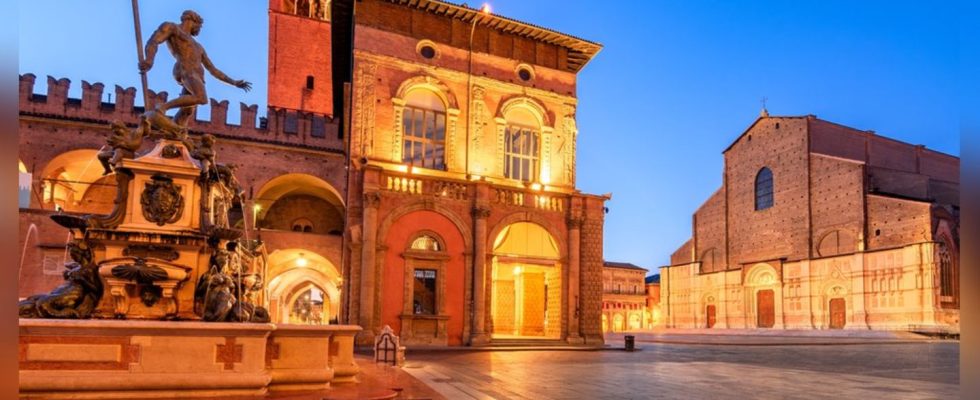Bologna
A city with many cultural highlights
The famous Fountain of Neptune in Piazza Maggiore in Bologna.
© Copyright (c) 2021 ecstk22/Shutterstock.
It doesn’t always have to be Rome. Bologna, the historic capital of Emilia-Romagna, also has plenty of treasures to offer.
Italy is not only famous for its beaches and culinary delights, the country is also full of sights. Annually more than 40 million tourists visit cities like Rome, Florence, Milan, Venice or Verona because of their varied art and cultural history.
In the northern Italian region of Emilia-Romagna alone, there are three art cities, Ferrara, Modena and Ravenna, which have been declared World Heritage Sites by Unesco. In addition, Parma is a “Unesco City of Gastronomy” and its baptistery has been recognized by Unesco as one of the most valuable sites in the world.
Art meets culture in Bologna
Widely underestimated when it comes to art and culture, Bologna is the historic capital of Emilia-Romagna. Attractions with over 50 museums and galleries, 40 kilometers of arcades, the Piazza Maggiore market square, the Neptune Fountain and the Palazzo D’Accursio offer visitors deep insights into the history of the city. Landmarks are the two medieval leaning towers Torre Garisenda and Torre Asinelli.
In addition, one should not leave Bologna without admiring the Palazzo Poggi, the 17th-century sundial and the ancient chapels of the Basilica of San Petronio, the portico and organ of Santa Maria dei Servi, and the art and culture center Manifattura delle Arti . Historical is also the oldest university in Europe – the Università di Bologna. The year 1088 is considered to be the hour of its birth. This educational veteran can therefore look back on almost 1,000 years of history.
The rich sightseeing program is supplemented with numerous attractions from the cultural calendar such as exhibitions, theater programs and music festivals. The opera and ballet season of the Teatro Comunale, the concerts of the Mozart Orchestra, the Bologna Festival and the film festival, which takes place every year as an open-air event on the Piazza Maggiore with old films that have been rediscovered or restored, are among the highlights in the diverse cultural program. The Bologna Welcome tourist office can also be found in the central square. Here you can buy tickets in advance, get brochures or get useful information about the city trip, such as the Welcome Card.
Delicious feast with regional products
Culinary treasures can be discovered right in the center, in the old market district of Quadrilatero. From the local Mortadella to Parmesan cheese, Parma ham, tortellini and Aceto Balsamico – foodies are guaranteed to get their money’s worth here. In the narrow streets you can feast on regional products from Emilia-Romagna. The traditional dish of Bologna, tagliatelle with ragú, and not incorrectly spaghetti Bolognese, is eaten preferably in the “Osteria del Cappello”, which was already mentioned in 1375 and where old family recipes are still used.
Hotels between modernity, art and tradition
The accommodation options are as varied as the city itself. The “L’8 Boutique Bologna” offers a stay between modernity, art and tradition in the middle of the city. Exposed beams, original bricks, frescoes and antique furniture have been preserved and combined with works of art and design objects. The apartments are furnished in boutique style. A special highlight: a dinner with a private chef.
You can also live stylishly around 15 kilometers south in the hills of Bologna, in the “Palazzo di Varignana Resort & Spa”. The resort impresses with private villas, modern rooms, terrace pools and its own Varsana spa.
Three restaurants spoil you with culinary delights: The “Trattoria Le Marzoline” located in a farmhouse, the “Aurevo Pool” restaurant and the fine dining restaurant “Il Grifone” in the Palazzo. The highlight is the “Treno Reale” restaurant: guests embark on a culinary journey into the past in a restaurant car from the royal train dating back to 1921 that has been restored with great attention to detail. A private art collection from all over the world belonging to the resort owner can be discovered on the premises and in the “Wunderkammer”. In the private chapel of the historic 1705 palazzo there are two other pieces of particular value: a faithful reproduction of the Gregorian calendar and an oil painting on canvas of Pope Gregory VIII.
Nature lovers check into the Bed & Breakfast “Le Tuie” near Bologna. Agricultural products and a private garden in a family-run farmhouse invite you to linger. Ideally located, Borgo Panigale train station and Bologna Airport are just 3 kilometers away. Excursions to the Therme San Luca or the Motor Valley near Bologna can be reached quickly. Famous automobile companies can be visited on 50 square kilometers: from Ferrari and Lamborghini to Maserati and Ducati to the Imola and Modena racetracks.
By plane, train or car to Bologna
Traveling to Bologna is easy by plane from many German airports. There is also a train connection from Munich to Ancona, which takes you to Bologna in 6.5 hours. A car journey takes you via Innsbruck and the Brenner pass to Verona and Modena to Bologna. Here it is important to take into account the respective tolls.

